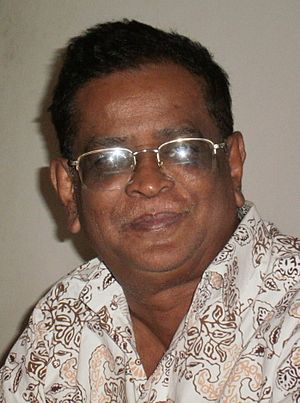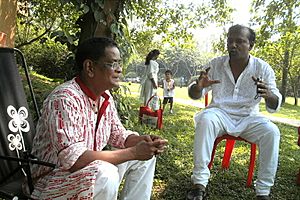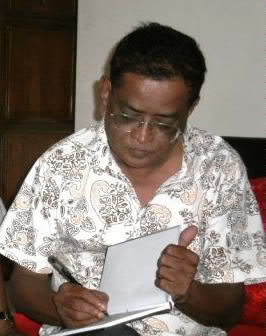Humayun Ahmed facts for kids
Quick facts for kids
Humayun Ahmed
|
|
|---|---|

Ahmed in 2010
|
|
| Native name |
হুমায়ূন আহমেদ
|
| Born | 13 November 1948 Netrokona, Mymensingh, East Bengal, Pakistan (Present Day Netrokona, Mymensingh Division, Bangladesh) |
| Died | 19 July 2012 (aged 63) New York City, United States |
| Resting place | Nuhash Polli, Pirujali, Gazipur, Bangladesh |
| Occupation | Writer, film director, academic, dramatist |
| Nationality | Bangladeshi |
| Education | PhD in polymer chemistry |
| Alma mater | University of Dhaka (BSc, MSc) North Dakota State University (PhD) |
| Years active | 1972–2012 |
| Notable awards | Bangla Academy Literary Award Ekushey Padak |
| Spouse |
|
| Children |
|
| Relatives |
|
| Signature | |
Humayun Ahmed (13 November 1948 – 19 July 2012) was a very famous writer, filmmaker, and professor from Bangladesh. He wrote over 200 books, including novels and non-fiction. Many of his books became bestsellers in Bangladesh. His books were the most popular at the Ekushey Book Fair for many years.
Humayun Ahmed was one of the most important writers and filmmakers in Bangladesh after it became independent. People called him a "cultural legend" of Bangladesh. He started making films in the early 1990s. He directed eight films, all based on his own novels. His films like Aguner Poroshmoni and Ghetuputra Komola won several Bangladesh National Film Awards. Many of his TV shows, like Kothao Keu Nei and Aaj Robibar, are still loved by many. He also wrote popular TV shows called soap operas.
Many people think Humayun Ahmed was the greatest Bangladeshi writer ever. His stories often showed everyday life, family situations, and humor. The Times of India newspaper called him "The Shakespeare of Bangladesh." This was because his writing was so important to Bengali literature. He won the Bangla Academy Literary Award in 1981 and the Ekushey Padak in 1994. These are two very important awards for writers in Bangladesh.
Contents
Early Life and Family Background
Humayun Ahmed was born on 13 November 1948. This was in a village called Kutubpur, in what was then East Bengal, Pakistan. Today, this area is part of Netrokona District in Bangladesh. His mother, Ayesha Foyez, was a homemaker. His father, Foyzur Rahman Ahmed, was a police officer. Sadly, his father was killed in 1971 during the Bangladesh Liberation War.
Humayun Ahmed had two brothers who also became famous. His brother, Muhammed Zafar Iqbal, is a well-known writer and professor. His other brother, Ahsan Habib, is a cartoonist. He also had three sisters. As a child, Humayun Ahmed lived in many different cities. This was because his father moved often for his police work.
Education and Early Career
Humayun Ahmed went to Chittagong Collegiate School. He finished his high school exams from Bogra Zilla School in 1965. Then, he went to Dhaka College. He studied chemistry at the University of Dhaka, earning both his bachelor's and master's degrees.
Later, he became a teacher at the same university. He also went to North Dakota State University to get his PhD in polymer chemistry. After finishing his studies, he came back to Bangladesh. He continued to teach chemistry at the University of Dhaka for several years.
His Amazing Works
Humayun Ahmed created many different types of stories. He wrote novels, TV shows, and films.
Popular Novels and Stories
Humayun Ahmed wrote his first novel, Nondito Noroke (meaning In Blissful Hell), in 1971. He was still a university student at the time. This book was published in 1972 and became very popular. His stories often focused on the lives of regular middle-class families. His second novel was Shonkhonil Karagar.
He created several popular character series. These include:
- Himu: A young man who lives by his own rules, often walking barefoot. There are 21 novels about Himu.
- Misir Ali: A professor who solves mysteries using logic and psychology. He appears in 19 novels and 11 short stories.
- Shuvro: A pure-hearted and idealistic young man. He is featured in 6 novels.
Humayun Ahmed also wrote many novels about the Bangladesh Liberation War. Some of these are Aguner Poroshmoni, 1971, and Jochona O Jononir Golpo. He also wrote many romantic novels. His novel Gouripur Junction was translated into nine different languages. He also wrote several autobiographies, sharing stories from his own life.
Television and Film Creations
Humayun Ahmed's first TV drama was Prothom Prohor in 1983. His first TV show series was Ei Shob Din Ratri in 1985. This show was very popular. He then created other famous TV series like:
- Bohubrihi (1988), a comedy.
- Ayomoy (1988), a historical drama.
- Kothao Keu Nei (1990), a city-based drama.
- Aaj Robibar (1999), another popular series.
He also directed films based on his own stories. His first film was Aguner Poroshmoni (1994). This film was about the Bangladesh Liberation War. It won eight Bangladesh National Film Awards. Another film, Shyamal Chhaya (2005), was also about the same war. His last film, Ghetuputra Kamola (2012), told the story of a teenage boy in the British colonial period. Both Shyamol Chhaya and Ghetuputra Kamola were sent to the Academy Award for Best Foreign Language Film from Bangladesh.
Music and Songs
Humayun Ahmed also wrote about 40 songs. He used these songs in his films and TV dramas. His songs were often inspired by the folk music of Bangladesh. Some of his famous songs include "Ekta Chhilo Shonar Konya" and "Jodi Mon Kadey." Many famous singers performed his songs.
Personal Life
Humayun Ahmed married Gultekin Khan in 1973. They had three daughters: Nova, Sheila, and Bipasha. They also had one son, Nuhash Humayun. Sheila Ahmed became an actress, and Nuhash became a writer and film director. Humayun Ahmed and Gultekin divorced in 2003.
In 2004, he married actress Meher Afroz Shaon. They had two sons together: Nishad and Ninith.
His Passing
In 2011, doctors found a cancerous tumor in Humayun Ahmed's colon. He went to New York City for treatment. During his time there, he wrote a novel called Deyal.
Humayun Ahmed passed away on 19 July 2012, in New York City. There was some discussion about where he should be buried. Finally, his family decided to bury him at his own estate, Nuhash Palli.
Nuhash Palli: His Special Place
In 1987, Humayun Ahmed created a special place called Nuhash Palli. He named it after his son, Nuhash. It is located near Gazipur City in Bangladesh. This estate is quite large, covering about 14 acres. He loved to spend a lot of his time there when he was in Bangladesh.
At Nuhash Palli, he collected many statues made by a local artist. He also gathered many different plants from all over the world. He especially liked medicinal and fruit-bearing trees.
His Lasting Legacy
Even after his death, Humayun Ahmed's work continues to inspire. An award program called Humayun Ahmed Sahitya Puruskar was created in his honor. It is given to two writers every year on his birthday.
Many of his stories have been made into films after his passing. For example, Anil Bagchir Ekdin (2015) won several national film awards. Krishnopokkho (2016) was directed by his wife, Meher Afroz Shaon. Another film, Debi (2018), was also based on his work.
Filmography
| Year | Film | Director | Screenwriter | Notes |
|---|---|---|---|---|
| 1992 | Shonkhonil Karagar | Mustafizur Rahman | Yes | Bangladesh National Film Award for Best Story |
| 1994 | Aguner Poroshmoni | Yes | Yes | Bangladesh National Film Award for Best Film Bangladesh National Film Award for Best Story Bangladesh National Film Award for Best Dialogue |
| 1999 | Srabon Megher Din | Yes | Yes | Bachsas Awards for Best Lyrics Bachsas Awards for Best Story |
| 2000 | Dui Duari | Yes | Yes | |
| 2003 | Chandrokotha | Yes | Yes | |
| 2004 | Shyamol Chhaya | Yes | Yes | Bangladeshi submission for the Academy Award for Best Foreign Language Film |
| 2006 | Durotto | Yes | ||
| Nondito Noroke | Belal Ahmed | Yes | ||
| Nirontor | Abu Sayeed | Yes | ||
| Noy Number Bipod Sanket | Yes | Yes | ||
| 2007 | Daruchini Dwip | Tauquir Ahmed | Yes | Bangladesh National Film Award for Best Screenplay |
| Saajghor | Yes | |||
| 2008 | Amar Ache Jol | Yes | Yes | |
| 2009 | Priyotomeshu | Yes | ||
| 2012 | Ghetuputra Komola | Yes | Yes | Bangladeshi submission for the Academy Award for Best Foreign Language Film Bangladesh National Film Award for Best Director Bangladesh National Film Award for Best Screenplay Meril Prothom Alo Awards - Best Film Meril Prothom Alo Awards - Best Director Meril Prothom Alo Awards - Best Screenplay |
| 2015 | Anil Bagchir Ekdin | the first film based on Ahmed's literary work after his death | ||
| 2016 | Krishnopokkho | Meher Afroz Shaon | ||
| 2018 | Debi | Anam Biswas |
Awards and Recognitions
Humayun Ahmed received many awards for his amazing work. Some of the most important ones include:
- Lekhak Shibir Prize (1973)
- Bangla Academy Literary Award (1981)
- Shishu Academy Award
- Zainul Abedin Gold Medal
- Michael Madhusudan Medal (1987)
- Bachsas Award for Best Story (1988)
- Humayun Qadir Memorial Prize (1990)
- Bangladesh National Film Award for Best Story (1994)
- Bangladesh National Film Award for Best Film (1994)
- Bangladesh National Film Award for Best Dialogue (1994)
- Ekushey Padak (1994)
- Sheltech Award (2007)
- Bangladesh National Film Award for Best Screenplay (2007)
- Bangladesh National Film Award for Best Director (2012)
- Bangladesh National Film Award for Best Screenplay (2012)
- Meril-Prothom Alo Award for best director (2013)
- Bangladesh National Film Award for Best Dialogue (2015)



